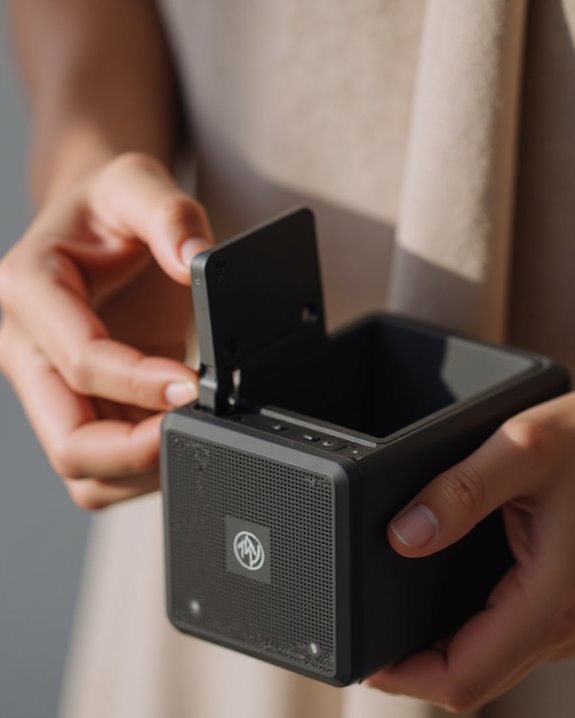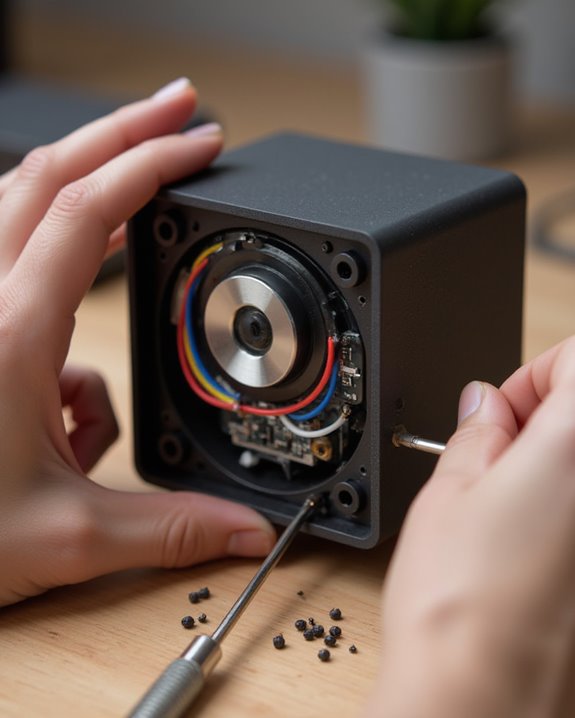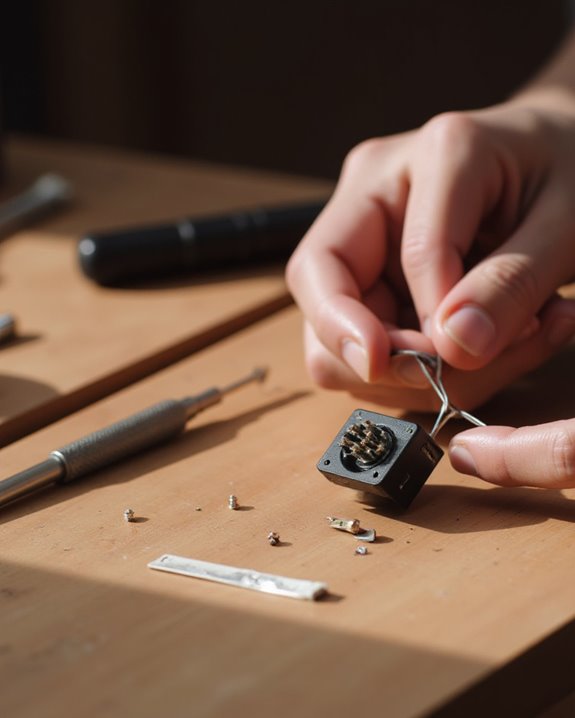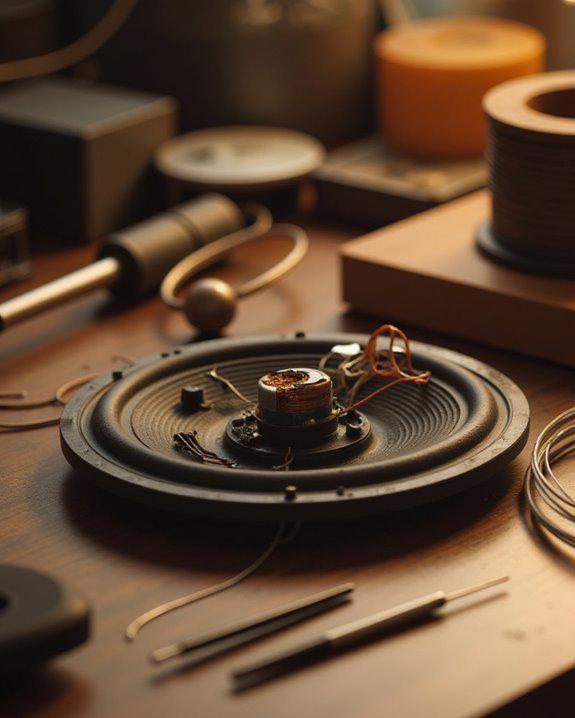Cleaning iPhone speakers requires a methodical approach for best results. First, power off the device completely to prevent accidental damage. Gather tools including a soft-bristled brush, painters tape, and a silicone air blower. Inspect speaker openings with a flashlight to identify debris buildup. Gently brush away surface particles, then use tape wrapped around a fingertip to lift stubborn dust. Apply short bursts of air to dislodge remaining debris. The following detailed steps will guarantee your speakers deliver clear, uncompromised sound quality.
Key Takeaways
- Power off your iPhone completely before cleaning to prevent accidental damage to internal components.
- Use a soft-bristled brush with gentle side-to-side motions to remove surface debris from speaker grills.
- Apply painters tape or masking tape wrapped around your fingertip to lift stubborn dust from speaker openings.
- Direct short bursts of compressed air or a silicone air blower at speaker holes to dislodge deeper particles.
- Test speaker performance after cleaning by playing audio and making a test call to verify improved sound quality.
Turn off Your Iphone Before Cleaning
Before beginning the speaker cleaning process, users should power down their iPhone completely to prevent any potential complications. This essential first step minimizes the risk of accidental screen touches or button presses that could interfere with debris removal from speaker holes. Powering down creates a controlled environment for safely addressing accumulated dirt in the delicate speaker components.
When the device remains on during cleaning, users may inadvertently push debris deeper into the iPhone speaker holes rather than removing it effectively. This precautionary measure aligns with Apple’s maintenance recommendations and follows standard safety protocols for electronic device care. By turning off the iPhone, users create ideal conditions for subsequent cleaning steps involving specialized tools like soft-bristled brushes or adhesive tape, ensuring that dirt and debris from speaker holes can be removed without risking electrical issues or unintended device responses.
Additionally, keeping the speaker clean helps maintain optimal performance for features like Bluetooth connectivity when pairing with external devices.
Gather Your Cleaning Tools and Materials

Assembling the appropriate cleaning tools represents a critical preparatory step before attempting any iPhone speaker maintenance. The collection should include a soft-bristled brush, such as a makeup or paint brush, which effectively removes dust and debris without scratching delicate components. Painters tape or masking tape serves as an excellent alternative to compressed air, safely collecting particles from speaker openings without leaving residue.
A wooden or plastic toothpick provides precision when dislodging visible obstructions from speaker holes, while a silicone air blower offers a controlled method to clean the speaker without the excessive force of compressed air canisters. Additionally, a flashlight proves invaluable for thorough inspection, illuminating hard-to-see dust and lint accumulations that might otherwise remain undetected. These simple tools, when used properly, guarantee safe and effective speaker maintenance.
Inspect Speaker Openings With a Flashlight
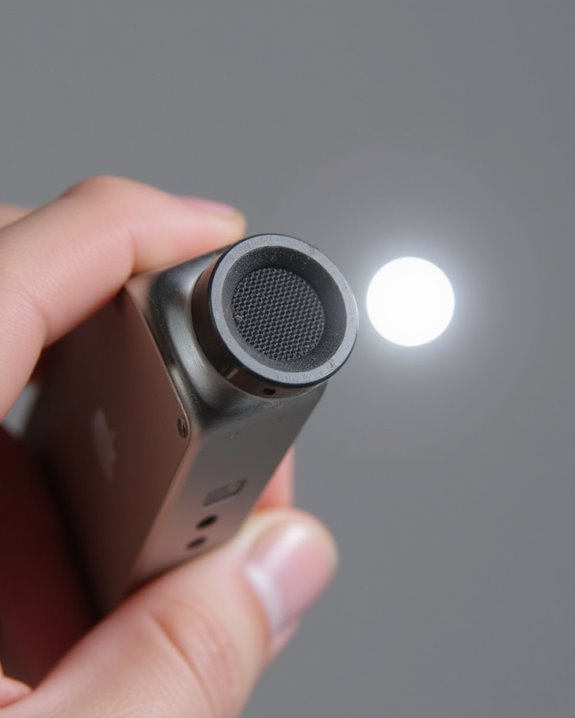
Illuminating the speaker openings with a flashlight represents the critical first step in any effective iPhone speaker cleaning regimen. By directing a bright LED flashlight at a slight angle toward the Iphone speaker holes, users can clearly identify dust, lint, and debris that obstruct sound quality. This inspection method reveals particles lodged in both the top receiver speaker and bottom main speaker opening that might otherwise remain invisible under normal lighting conditions.
Careful examination of the speaker grill often reveals build up of dirt similar to that reported in iPhone 8 models, which commonly causes audio distortion and volume reduction. This preliminary assessment helps determine the extent of clogging before proceeding with cleaning tools, preventing unnecessary probing of speaker holes that might not require intervention, and ensuring targeted cleaning efforts where truly needed.
Gently Brush Away Surface Debris
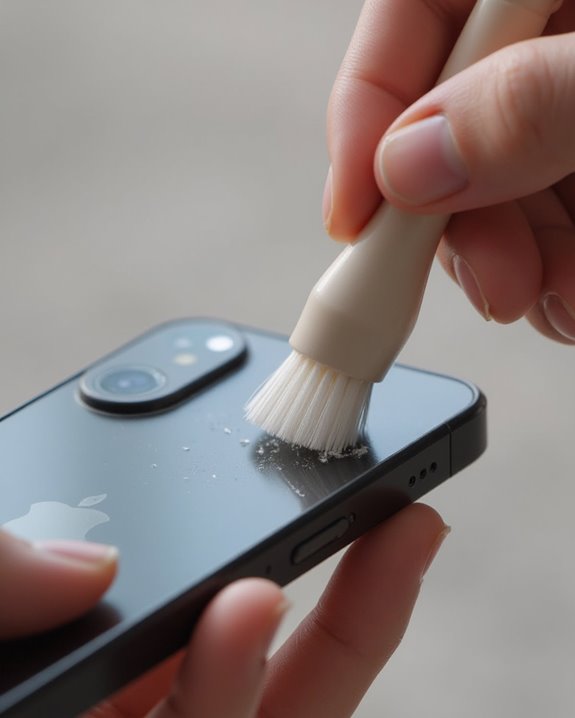
Tackling surface debris requires a methodical approach with the proper tools at hand, establishing the foundation for effective iPhone speaker cleaning. Users should select a soft-bristled brush, such as a clean makeup or paint brush, which provides the best way to clean without damaging delicate components. When addressing dirt in my speaker issues, gentle side-to-side motions across the receiving speaker at the top of the iPhone effectively dislodge accumulated particles.
For the iphone speaker holes at the bottom of the device, careful insertion of soft bristles with gentle rotation extracts embedded debris without pushing it deeper. This technique guarantees thorough cleaning while maintaining the integrity of the speaker components. Users should maintain light pressure throughout the process, as excessive force could compromise audio quality or damage the internal mesh covering the speaker openings.
Use Painters Tape for Stubborn Dust
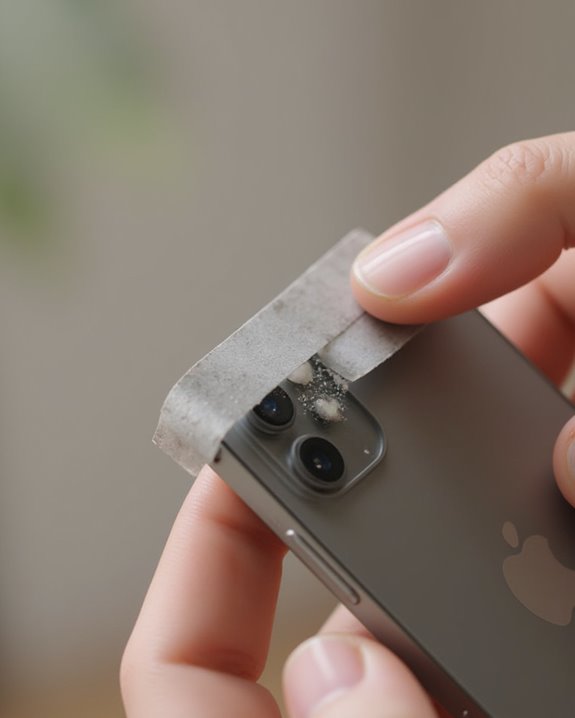
For stubborn dust particles that resist brush removal, painters tape offers an ingenious solution that effectively extracts debris from iPhone speaker openings. Before attempting this method, users should remove their case and screen protector to gain complete access to the holes on my iPhone where dirt accumulates.
A flashlight can illuminate the iPhone speaker holes, revealing precisely where concentrated cleaning efforts are needed. To clean the line of speaker openings, wrap a small piece of painters tape around a fingertip with the adhesive side facing outward. When confronted with dirt in it?how best to proceed, remember to gently roll the tape-covered finger over the speaker grills without applying pressure. This technique lifts stubborn dust particles while preventing debris from being pushed deeper into the device’s sensitive components.
Try a Wooden Toothpick for Visible Blockages
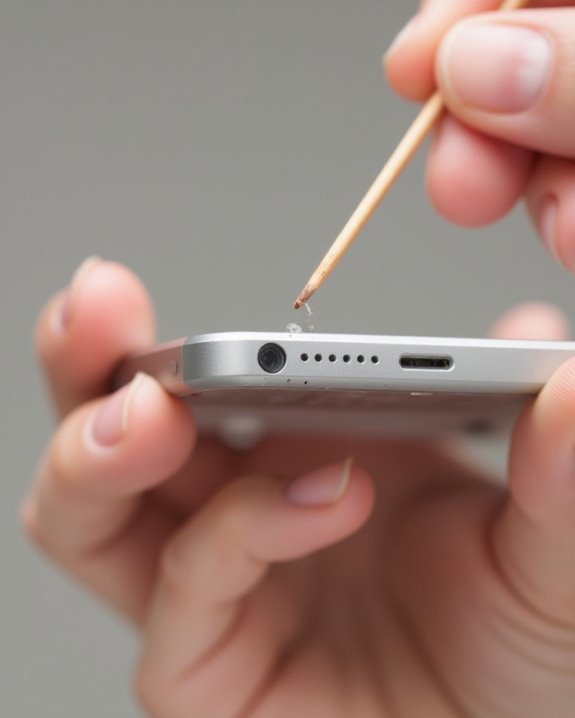
When regular cleaning methods fail to dislodge visible debris, a wooden toothpick provides a precise tool for addressing stubborn blockages in iPhone speakers. Users have reported success with this technique, particularly for the lower speaker holes without causing damage to the delicate components. First, use a flashlight to examine the area where you’ve noticed a build-up of dirt or debris.
Hold the iPhone securely and gently insert the wooden toothpick into the affected speaker holes, carefully tilting it to flick out visible particles rather than pushing them deeper. This method answers the question of how do you clean speakers with visible blockages while minimizing risk. Always choose wooden or plastic implements over metal objects, which can scratch or damage the speaker mesh, and only attempt this technique when blockages are clearly visible.
Apply Short Bursts With an Air Blower
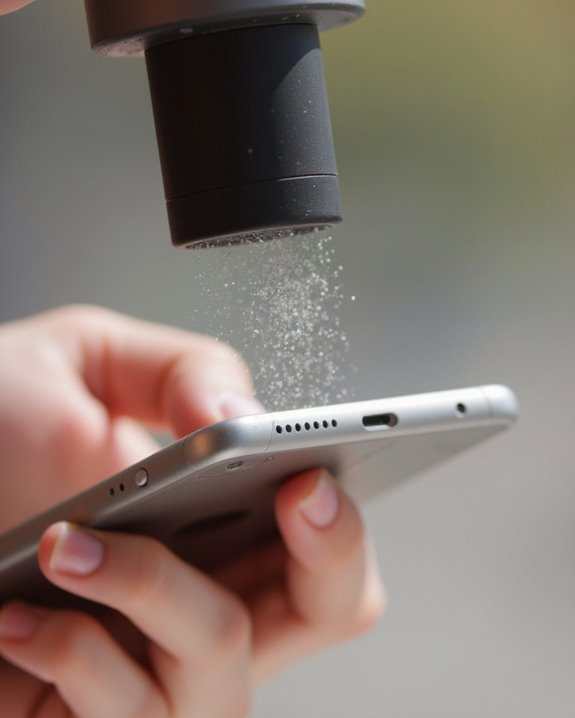
Gentle air blowing provides an effective, non-contact method for cleaning iPhone speakers when significant dust has accumulated beyond the reach of basic techniques. A silicone air blower offers a safer alternative to compressed air, which might damage sensitive components in the front or top iPhone speaker holes. Users should hold the blower a short distance from the device, directing the nozzle precisely at the speaker openings for targeted cleaning.
When considering how to clean iPhone speakers thoroughly, experts recommend applying brief bursts lasting only one to two seconds each. This controlled approach prevents pushing debris deeper into the openings while effectively dislodging stubborn particles. For best results, implement this technique after using brushes or tape, as the combination of methods enhances overall cleaning effectiveness and helps restore proper audio quality.
Clean the Receiving Speaker Near the Screen
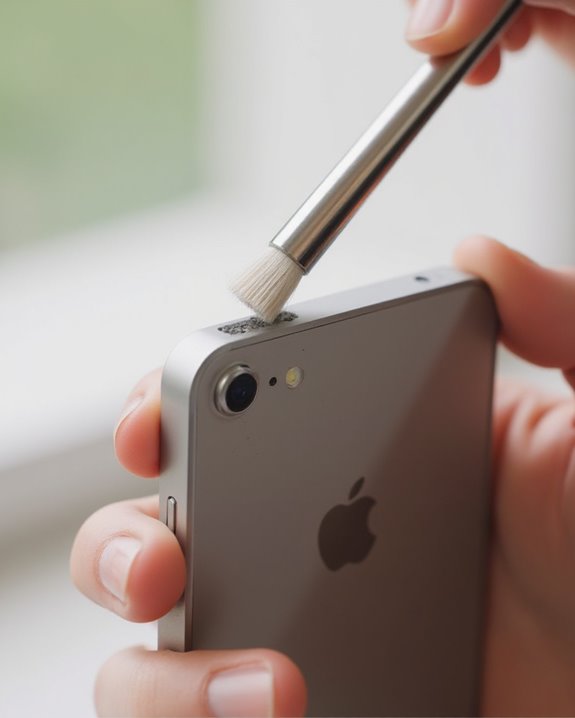
The receiving speaker near the screen represents one of the iPhone’s most critical audio components, often accumulating dust and debris that directly impact call clarity and overall sound quality. To properly clean this area, first remove the phone case and any screen protector to gain unobstructed access to the speaker on the front of the iPhone. Using a soft-bristled brush, gently sweep across the iPhone speaker holes in a side-to-side motion, being careful not to apply excessive pressure. For enhanced visibility, shine a flashlight onto the front of the iPhone to identify remaining particles. This illumination allows users to target stubborn debris lodged within the speaker’s small openings. After cleaning, inspect the area again with the flashlight to confirm all particles have been successfully removed from this essential component.
Test Sound Quality After Cleaning
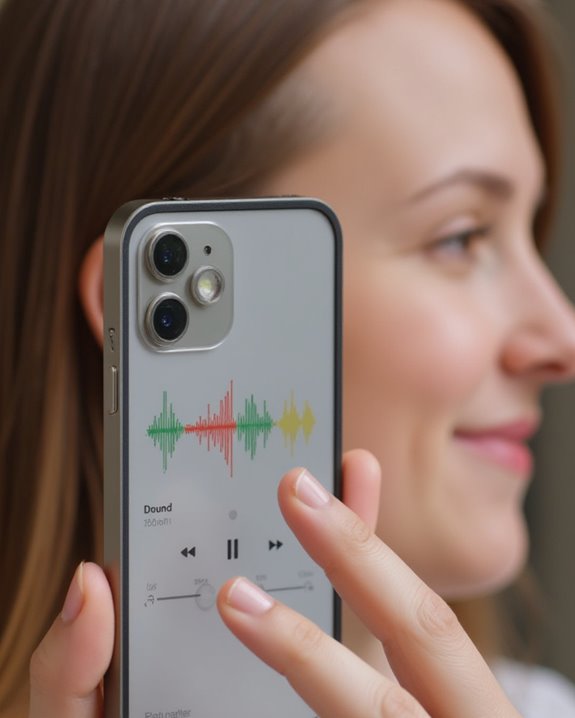
After meticulously cleaning the speaker components, evaluating the sound quality represents a necessary verification step to confirm the maintenance produced the desired results. Users should play familiar audio at medium volume through the iPhone speaker holes to determine if previously muddy sound has improved, noting specific details like bass clarity and high-frequency response.
Making a test call through the Phone app offers another validation method, as voices should sound clearer through the front of your phone’s receiving speaker. Compare pre-cleaning and post-cleaning performance using identical media content, which helps identify subtle improvements in audio quality. If issues persist after proper cleaning methods, the problem may stem from software rather than debris blockage.
Those who use the iPhone regularly should incorporate these testing procedures after each cleaning session to maintain best sound performance.
Preventative Maintenance Tips

Regularly implementing preventative maintenance greatly extends the lifespan of iPhone speakers while maintaining ideal audio performance. Establishing a bi-weekly PM schedule allows users to inspect iPhone speaker holes with a flashlight, identifying dust accumulation before it causes audio distortion. When performing these inspections, always use a clean, soft-bristled brush to gently sweep away debris, being careful not to push particles deeper into openings.
Device protection accessories require attention as well, as cases and screen protectors should be removed and cleaned separately to prevent lint from collecting around speaker openings. Users should also maintain cleanliness around the charging port using similar gentle techniques. For thorough preventative care, occasional software checks are recommended, as system issues can sometimes manifest as apparent speaker problems, potentially saving unnecessary physical cleaning attempts.
Frequently Asked Questions
How Do I Clean the Speaker on My Iphone?
Like delicate whispers through a dusty veil, iPhone speakers need care. Speaker hygiene involves brushing with soft bristles, applying painter’s tape for dust prevention, and using toothpicks for grille care. Routine upkeep maintains best sound quality.
How Can I Make My Iphone Speakers Sound Better?
iPhone audio performance improves through regular cleaning, volume optimization, and audio tweaks within settings. Users can achieve sound enhancement by removing debris with soft brushes and enhance bass boost through EQ adjustments in the Music settings.
How Do You Get Water Out of Your Iphone Speaker Fast?
To remove water from iPhone speakers quickly, users can utilize Water Ejection by tapping the device bottom-down. This Moisture Technique dislodges trapped liquid. The Drying Method includes using silicone air blowers for Fast Removal of speaker water.
How to Clean Your Iphone?
Properly pristine iPhones require regular maintenance. Users should focus on screen cleaning with microfiber cloths, port dusting using soft brushes, case wiping with disinfectant wipes, and button sanitizing with alcohol solutions for best device performance.


